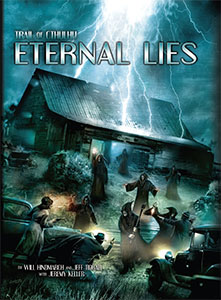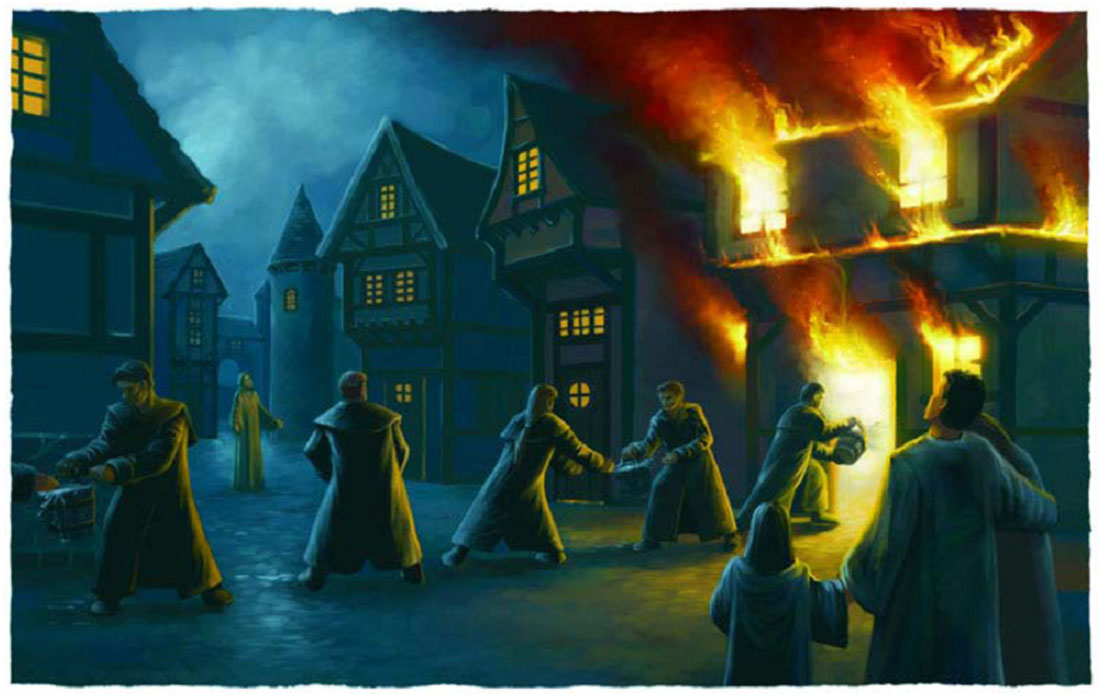IN THE SHADOW OF THE SPIRE
Session 3A: On the Murderer’s Trail
In which a fire is unleashed which will haunt the wanderers for many moons to come and a man of ill-repute is brought to a much deserved justice…
For the house fire found in this installment of In the Shadow of the Spire I used a set of custom rules I had designed for handling encounters inside burning buildings. These rules were actually posted here on the Alexandrian way back in 2007 and you can find them under the title Advanced Rules: Fire.
Intriguingly, a few months later, I got a bunch of flak for these rules on a forum: They proved I was a hopeless grognard who had never actually played an RPG because it would be completely ridiculous to use these rules to model huge conflagrations like, say, the Great Fire of London. (Which is true in much the same way that it would be ridiculous to use D&D’s combat rules to model the Battle of Waterloo: It’s true, but completely irrelevant.)
As you can see, of course, these rules were designed to handle fires in small buildings. If I was going to expand the system to handle large conflagrations — like, say, a skyscraper — I’d probably look at adding a more abstract system for handling the spread and severity of the fire in areas where the PCs weren’t immediately interacting with it. For even larger conflagrations, it’s likely that I would handle them in a more narrative fashion (as I did in Mini-Adventure 2: The Black Mist), using the larger crisis to frame scenes with more immediate challenges that the PCs could actually cope with. (Unless, for some reason, the PCs were in the position of trying to put out or contain the fire, in which case I’d still try to find a mechanical structure for them to do that within.)
If you’ve read my discussion of Game Structures, you can probably see where I’m going with this: By creating a custom game structure, you’re giving the players a toolkit for interacting with the situation. When properly designed, these custom structures are incredibly empowering because they can isolate the GM’s preconceptions about the situation and give the players the freedom to craft outcomes which are utterly unique.
 (As another example of this, consider the heat track used in my Eternal Lies campaign: Robust mechanical distinctions between traveling, camping, and resting at oases were then tied to the recovery mechanics for characters suffering from heat exposure. This created meaningful decisions about rate and method of travel. Once you’ve added the risk of pursuit or the consequences of time passing outside the desert (both of which are true in the scenario), this results in the players making meaty decisions with potentially long-term consequences.)
(As another example of this, consider the heat track used in my Eternal Lies campaign: Robust mechanical distinctions between traveling, camping, and resting at oases were then tied to the recovery mechanics for characters suffering from heat exposure. This created meaningful decisions about rate and method of travel. Once you’ve added the risk of pursuit or the consequences of time passing outside the desert (both of which are true in the scenario), this results in the players making meaty decisions with potentially long-term consequences.)
When designing a custom game structure to handle a situation in your game, the first thing I recommend is making sure that it’s a flexible tool instead of just reinforcing your preconceptions about how the scene should be resolved. (For example, if the only mechanical interaction in your structure for handling house fires is “putting the fire out”, then the players have little choice but to put the fire out.)
Second, the structure needs to either be simple enough that it can be rapidly explained or it needs to be player-unknown (in the sense that the players don’t need to fully understand the structure; they can simply make decisions in character and the GM can use the structure to invisibly make rulings). You generally don’t want to create situations where the game grinds to a halt so that you can explain a custom mechanical structure to the players.
An exception can be made for structures that are going to impact a broad swath of gameplay. (Like the Eternal Lies heat track mechanics, which influenced two full sessions of play.) A related technique is to introduce the custom game structure through minor encounters so that the players can then take full, experienced advantage of it during the big, important scene. (You get more bang for your buck this way, and the players get the satisfaction of gaining and then exploiting mastery of the system.)













Hi Justin,
how do you make sure that game structures you create are mathematically sound. That is, what guidelines do you use to choose things such as DCs, damage values and so on?
Cheers,
Wolf